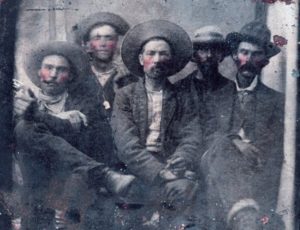Use Cmd/Ctrl+F to search Provenance.
Working links are Red, other references, use Navigation Panel choices.
Names in bold will be found in Players or Dictionary
Bolded Titles in References – Books (two lists).
Provenance
So you think you might have a “new” picture or a tintype
of some western notable?
Maybe grandpa gave you a gun from someone notorious?
What is this thing called provenance?
Old West Daily Reader receives calls and emails from folks who think they have turned up a photograph or some historical item that no one else has yet seen. Unlikely, but it could be, it does happen…
Just for starters, here are some of the issues you need to be prepared to address, to prove your case.

How did you come by the item?
Any chance that you can prove a chain of possession
of the item from its creation (photos), or original owner (things) to your hand?

Firearms and other items…
Is there a verifiable photo of the original owner with the item?
Letters or correspondence with a business referring to the item?
Newspaper articles, factory and court records and such
help turn up ownership, serial numbers and purchase records for firearms.
Is the item marked in some unique way which identifies the original owner?
With Colts, Winchesters and some others, factory records might identify an original purchaser.
A gentleman of my acquaintance, was in possession of a Colt Revolver (of the correct vintage), which had come from his grandfather in Alaska, with a letter stating that it was the gun used to kill Soapy Smith at The Shootout on Juneau Wharf in 1898*. Problem is, the trial court of the time, did not record the serial number of the firearm, even though it was produced in court. Thus, there was insufficient provenance on the gun to bring high dollar. I read the letter, I think it is that gun. Some years back, it was sold to a bar in Tombstone, AZ. – Doc
Doc Holliday’s 1866 Remington Derringer just turned up (2016). It had sufficient provenance with it, to prove that it really was Doc’s.
see:
Doc Holliday’s Guns

Photographs, tintypes, etc.
Who do you think made the original? Why do you think that?
Where was it supposed to have been made?
Can you show that the subject was ever at the place
where the original was thought to have been created?
Can you demonstrate that they were there or somewhere near at the correct time?
Is the photo signed, dated or marked by a photographer or the subject?
These are some of the things that would constitute provenance for a photograph or any historical item; the proof and verification that it is actually as claimed. There is also the information that is intrinsic to the photograph. Are the clothes, the buildings, the horse tack, the weapons, everything in the picture, actually within the lifetime of the subject? Intrinsic information also includes the composition of the photo itself. Do some study on the history of photography and photographic processes. Is it a cyanotype, daguerreotype, tintype or something else? Wrong format for the time denotes a fake. Collectors/sellers have to do their homework.
see:
References – Dictionary – Photography in the Old West
More on Photographs…
With a photo, there will also be the various forensic opinions (anthropologists and artists) as to whether the subject is actually the person in question. Almost always, fraught with disagreement between “experts” and rarely sufficient to create high value, if it’s the only “proof” of the subjects identity. Photographs listed on eBay and other auctions can and do have misinformation, either by mistake or on purpose. Researching and learning a photograph’s provenance is essential. Far too many of those who want to sell photos are “sure” they can recognize the subject and become convinced that they alone are correct in their identification. They often don’t understand provenance or they discount it. The controversy surrounding the “New” Doc Holliday** photo and the several “New” Billy the Kid*** photos are a good examples (see: references below). The court of historical opinion can be brutal.
Oh, and don’t get caught up in the thought that you must “protect” the image, lest it be stolen. If, as likely with these things, its pre-1923, it is already in the public domain and you can’t copyright it. Make a low resolution copy and put it out on the internet and see if you can get some help proving it’s what you claim it is. Understand that the value, if any, is only in the item itself, not any copies.
A copy of the tintype of Billy the Kid is out there everywhere*. Only the original in Bob McCubbin‘s Collection is worth the 1.2 million alleged to have been paid for it. There are numerous classic examples of photos of famous personages with not quite enough provenance. The outlaw Jesse Evans**** and Sioux Chief Crazy Horse***** are two that come to mind. Both photos and some others of dubious identity, can be found on Old West Daily Reader.
Note well what happened when the “New” photo of Doc Holliday was discovered in 2015. True West Magazine did precisely what I suggested above. They put the photo out on the the internet and the response/information/discussion was huge! There is also a good current flap (2016) about the “new” Billy the Kid croquet picture. This too, published for public input.

It happened again! Here is another Billy the Kid!
Here is the latest “Billy” image discovered.

Billy the Kid (2nd from left) Pat Garrett (right) c. 1880
– A tintype, the Image is reversed –
in the collection of Frank Abrams
Photo: U.S. PD 1880 – Fair Use
Six years ago at a flea market, North Carolina, lawyer Frank Abrams bought an old tintype for $10. Later, when the picture next below was discovered, verified and valued at $5 million, Mr. Abrams was motivated to take another look at his photograph. Some research on Google led him to realize that the man on the right in the picture was a Western icon. “Oh my gosh,” he recalled saying. “That is Pat Garrett in my picture.”
That caused him to wonder about the man in the back with the prominent Adam’s apple. He finally showed the tintype to an expert on Billy the Kid and retired Arizona State University professor Robert Stahl encouraged him to show the image to other experts. William Dunniway, a tintype expert, said the photograph was almost certainly taken between 1875 and 1880. “Everything matches: the plate, the clothing, the firearm,” he said in a phone interview. Mr. Dunniway worked with a forensics expert, Kent Gibson, to conclude that Billy the Kid and Mr. Garrett were indeed pictured.
Go thou and do likewise with your discovery…

For further examples of the issue in Old West Daily Reader
see also:
*Wk 27, 07/08/1898 – Shootout on Juneau Wharf
Photo Gallery Index – Weapons Photos – Firearms Photos
– Marcel’s Guns – 22nd photo – Colt SAA ’73
**(see: PLAYERS – Timelines – Timelines A-L – Doc Holliday Timeline
***(see: PLAYERS – Timelines – Timelines A-L – Billy the Kid Timeline
****( and: Wk. 12, 03/22/1882 – Jesse Evans
*****(see: Photo Gallery – Indian Photos – Crazy Horse (a provenance issue)
Photo Gallery Index – Weapons Photos – Firearms – Marcel’s Guns – 14th photo
– Wesson and Levitt 1849 .40 cal. Read Marcel’s comment on the gun’s provenance.
Photo Gallery Index – Billy the Kid Photos
Photo Gallery Index – Doc Holliday Photos
References – Dictionary – Photography in the Old West
 Good Luck and Good Hunting! – Doc
Good Luck and Good Hunting! – Doc
{001} C 02/24; E 02/24; F 07/17; P 08/17
[whohit]-Provenance-[/whohit]